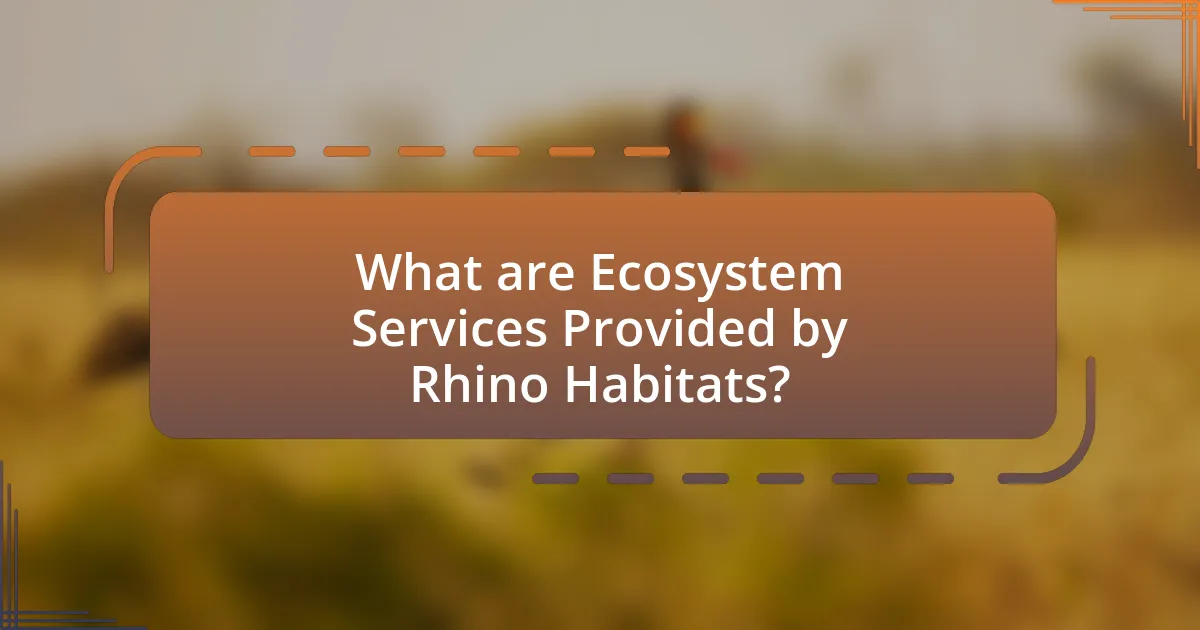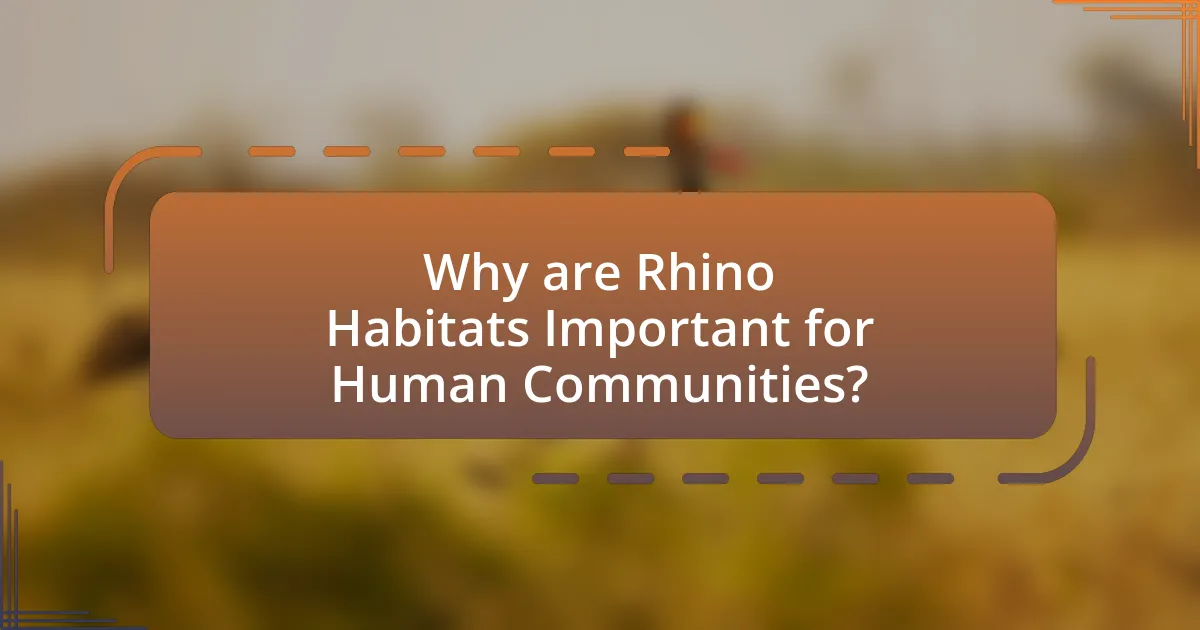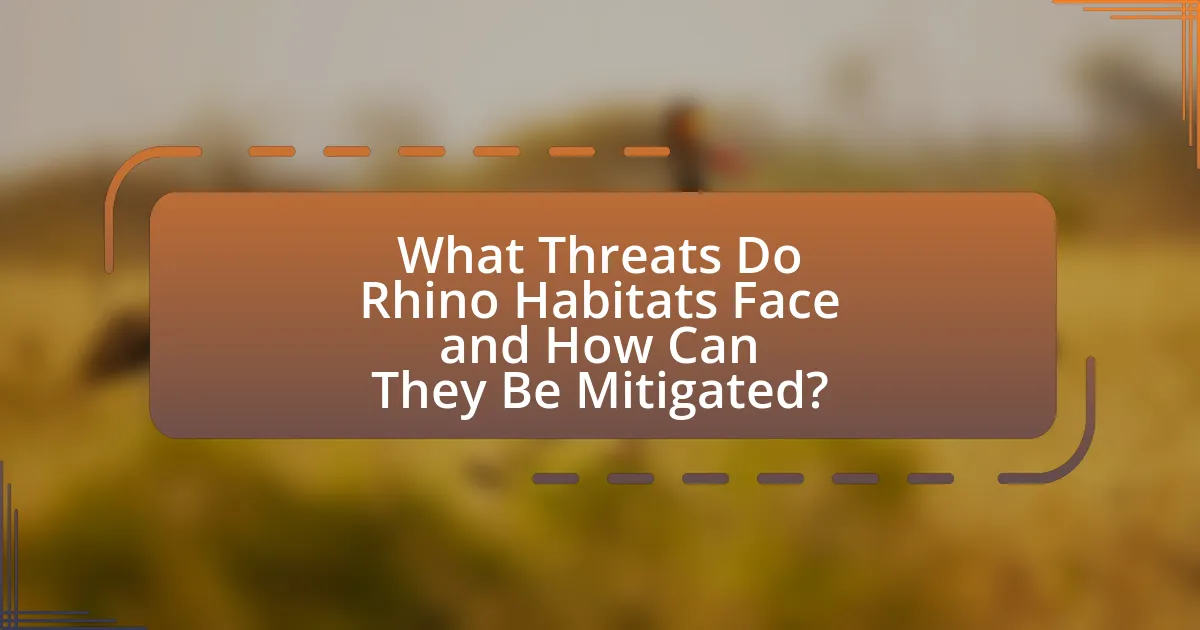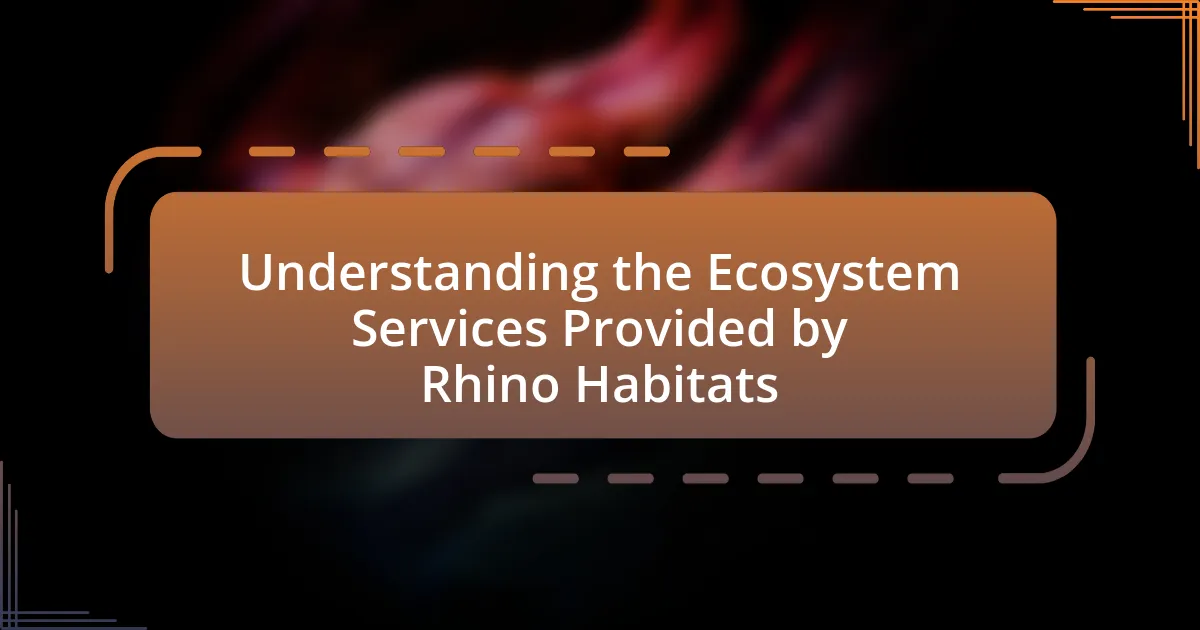Rhino habitats are critical ecosystems that provide essential services such as biodiversity support, soil health maintenance, and water regulation. These habitats foster diverse flora and fauna, with rhinos playing a key role in maintaining ecological balance through their grazing behavior. Additionally, rhino habitats contribute to carbon sequestration, helping mitigate climate change, and support local human communities by enhancing agricultural productivity and promoting eco-tourism. The article examines the various ecosystem services provided by rhino habitats, the species that depend on them, the threats they face, and effective conservation strategies to protect these vital environments.

What are Ecosystem Services Provided by Rhino Habitats?
Rhino habitats provide essential ecosystem services, including biodiversity support, soil health maintenance, and water regulation. These habitats contribute to biodiversity by offering a unique environment for various species, which helps maintain ecological balance. Additionally, rhinos play a crucial role in shaping their environment through grazing, which promotes the growth of certain plant species and prevents overgrowth, thus enhancing soil health. Furthermore, the presence of rhinos and their habitats aids in water regulation by maintaining watershed health, which is vital for both wildlife and human communities. Studies have shown that areas with healthy rhino populations often exhibit improved ecosystem resilience and functionality, underscoring the importance of these services.
How do rhino habitats contribute to biodiversity?
Rhino habitats contribute to biodiversity by providing essential ecosystems that support a wide range of flora and fauna. These habitats, such as grasslands and savannas, create niches for various species, promoting ecological interactions and species diversity. For instance, the presence of rhinos helps maintain the structure of these ecosystems through their grazing habits, which can prevent overgrowth of certain plant species, thereby allowing other plants and animals to thrive. Research indicates that areas with rhinos often have higher species richness, as their activities create a mosaic of habitats that benefit numerous organisms, including birds, insects, and smaller mammals.
What species depend on rhino habitats for survival?
Various species depend on rhino habitats for survival, including elephants, various antelope species, and numerous bird species. These animals rely on the vegetation and ecosystem dynamics created by rhinos, which help maintain the grasslands and open areas essential for their feeding and breeding. For instance, elephants benefit from the same habitats as they often share resources and create pathways that facilitate movement for other species. Additionally, the presence of rhinos contributes to biodiversity, as their grazing patterns promote a variety of plant growth that supports different herbivores and the predators that rely on them.
How do rhinos influence the ecosystem dynamics?
Rhinos influence ecosystem dynamics primarily through their grazing behavior, which helps maintain the structure of grasslands and savannas. By consuming large amounts of vegetation, rhinos prevent overgrowth, allowing a diverse range of plant species to thrive. This grazing activity promotes biodiversity, as various plants provide habitats and food sources for numerous other species. Additionally, rhinos contribute to nutrient cycling; their dung enriches the soil, fostering plant growth and supporting the overall health of the ecosystem. Studies have shown that areas with healthy rhino populations exhibit greater plant diversity and improved ecosystem resilience, highlighting their critical role in maintaining ecological balance.
What role do rhino habitats play in carbon sequestration?
Rhino habitats play a significant role in carbon sequestration by storing carbon in vegetation and soil. These ecosystems, primarily grasslands and savannas, support diverse plant life that absorbs carbon dioxide during photosynthesis. Research indicates that healthy grassland ecosystems can sequester up to 1.5 billion tons of carbon annually. Additionally, the presence of rhinos helps maintain the structure of these habitats, promoting biodiversity and enhancing their capacity to store carbon. The grazing behavior of rhinos encourages the growth of certain plant species that are more effective at carbon capture, further contributing to the overall carbon sequestration potential of these habitats.
How do rhino habitats help mitigate climate change?
Rhino habitats help mitigate climate change by sequestering carbon dioxide and maintaining biodiversity. These ecosystems, such as savannas and grasslands, store significant amounts of carbon in their vegetation and soil, which reduces greenhouse gas concentrations in the atmosphere. For instance, a study published in the journal “Global Change Biology” found that intact grassland ecosystems can sequester up to 1.5 billion tons of carbon annually. Additionally, rhinos contribute to the health of these habitats by grazing, which promotes plant diversity and resilience, further enhancing carbon storage capabilities.
What are the implications of carbon storage in these ecosystems?
Carbon storage in rhino habitats significantly mitigates climate change by sequestering atmospheric CO2, thus reducing greenhouse gas concentrations. These ecosystems, such as grasslands and forests, act as carbon sinks, storing large amounts of carbon in biomass and soil. For instance, studies indicate that tropical forests can store up to 200 gigatons of carbon, highlighting their critical role in global carbon cycles. Additionally, effective carbon storage enhances biodiversity, as healthy ecosystems support a variety of species, including rhinos, which contribute to ecological balance. This interplay between carbon storage and biodiversity underscores the importance of conserving rhino habitats for both climate regulation and species preservation.
How do rhino habitats support water regulation?
Rhino habitats support water regulation by maintaining the hydrological cycle through vegetation that absorbs and retains water. The presence of rhinos in these ecosystems promotes the growth of grasses and shrubs, which play a crucial role in preventing soil erosion and facilitating groundwater recharge. Studies indicate that areas with healthy rhino populations exhibit improved water quality and availability, as the vegetation helps filter pollutants and regulate stream flows. This ecological balance is essential for sustaining both wildlife and human communities that rely on these water resources.
What mechanisms do rhino habitats use to maintain water quality?
Rhino habitats maintain water quality through natural filtration processes, vegetation management, and soil stabilization. The presence of diverse plant species in these habitats helps filter pollutants and sediments from water sources, while root systems prevent soil erosion, which can lead to sedimentation in water bodies. Additionally, rhinos contribute to nutrient cycling through their grazing habits, which promotes healthy plant growth and enhances the overall ecosystem’s ability to purify water. Studies have shown that well-managed habitats with healthy rhino populations exhibit improved water clarity and quality, supporting both wildlife and human communities.
How does the presence of rhinos affect local water cycles?
The presence of rhinos positively affects local water cycles by promoting vegetation growth and maintaining wetland ecosystems. Rhinos contribute to the ecosystem through their grazing habits, which help control plant overgrowth and create open areas that allow water to infiltrate the soil. This process enhances groundwater recharge and maintains moisture levels in the environment. Additionally, their dung enriches the soil with nutrients, fostering plant diversity that further stabilizes the soil and reduces erosion, thereby improving water retention. Studies have shown that areas with healthy rhino populations often exhibit better water quality and availability, demonstrating their crucial role in sustaining local hydrological systems.

Why are Rhino Habitats Important for Human Communities?
Rhino habitats are important for human communities because they provide essential ecosystem services that support biodiversity, water regulation, and tourism. These habitats contribute to the health of ecosystems, which in turn benefits agricultural productivity and water quality for nearby human populations. For instance, rhinos help maintain grassland ecosystems, which can enhance soil fertility and reduce erosion, directly impacting agricultural yields. Additionally, the presence of rhinos attracts eco-tourism, generating revenue and employment opportunities for local communities. According to a study by the World Wildlife Fund, eco-tourism related to rhinos can significantly boost local economies, demonstrating the financial benefits of preserving these habitats.
How do rhino habitats contribute to local economies?
Rhino habitats contribute to local economies primarily through ecotourism, which generates significant revenue for communities. For instance, in countries like South Africa, rhino-related tourism can bring in millions of dollars annually, supporting local businesses such as hotels, restaurants, and guides. Additionally, these habitats provide ecosystem services like water purification and soil stabilization, which enhance agricultural productivity, further benefiting local economies. Studies indicate that areas with healthy rhino populations often see increased economic activity, as wildlife conservation efforts attract tourists and create jobs, thereby improving the livelihoods of local residents.
What are the economic benefits of ecotourism related to rhinos?
Ecotourism related to rhinos generates significant economic benefits by attracting tourists, which in turn supports local economies. For instance, in countries like South Africa, rhino-focused ecotourism contributes millions of dollars annually through park entrance fees, guided tours, and accommodation services. This influx of revenue creates jobs in local communities, with studies indicating that each rhino can generate approximately $1 million over its lifetime through tourism-related activities. Additionally, the preservation of rhino habitats through ecotourism fosters biodiversity, which can enhance ecosystem services that further benefit agriculture and fisheries in surrounding areas.
How do rhino habitats support agriculture and livelihoods?
Rhino habitats support agriculture and livelihoods by maintaining ecosystem balance and promoting biodiversity, which enhances agricultural productivity. These habitats provide essential services such as soil fertility through nutrient cycling and water regulation, which are crucial for farming. For instance, the presence of rhinos helps to manage vegetation, preventing overgrowth that can hinder crop production. Additionally, healthy ecosystems attract pollinators and other beneficial species that contribute to higher yields. Research indicates that areas with diverse wildlife, including rhinos, often experience improved agricultural outcomes, as seen in studies conducted in African savannas where wildlife conservation and farming coexist.
What cultural significance do rhinos and their habitats hold?
Rhinos and their habitats hold significant cultural importance as symbols of wildlife conservation and biodiversity. In various cultures, rhinos are revered for their strength and resilience, often appearing in folklore and traditional art, which reflects their status as iconic species. For instance, in African cultures, the rhino is associated with power and protection, influencing local customs and rituals. Additionally, rhino habitats, such as savannas and grasslands, are integral to the livelihoods of many indigenous communities, providing resources like food and materials, thus reinforcing the connection between cultural identity and environmental stewardship. The decline of rhinos and their habitats threatens not only biodiversity but also the cultural heritage tied to these majestic animals, highlighting the need for conservation efforts to preserve both ecological and cultural values.
How do local communities perceive rhinos in their culture?
Local communities often perceive rhinos as symbols of cultural heritage and biodiversity. In many African cultures, rhinos are associated with strength and resilience, often featuring in folklore and traditional practices. For instance, the Maasai people of Kenya view rhinos as a vital part of their ecosystem, reflecting their connection to the land and wildlife. Additionally, rhinos contribute to local economies through eco-tourism, which enhances their cultural significance. Studies indicate that communities engaged in conservation efforts often develop a deeper appreciation for rhinos, recognizing their role in maintaining ecological balance and supporting livelihoods.
What traditional practices are linked to rhino conservation?
Traditional practices linked to rhino conservation include community-based wildlife management and the use of traditional ecological knowledge. Community-based wildlife management involves local communities actively participating in the protection and management of rhino populations, which fosters a sense of ownership and responsibility. Traditional ecological knowledge, passed down through generations, often includes sustainable land-use practices that benefit both rhinos and their habitats. For example, some indigenous groups have historically practiced controlled burning to maintain grasslands, which supports the ecosystem that rhinos rely on. These practices have been shown to enhance biodiversity and contribute to the overall health of rhino habitats, thereby supporting conservation efforts.

What Threats Do Rhino Habitats Face and How Can They Be Mitigated?
Rhino habitats face significant threats including habitat loss, poaching, and climate change. Habitat loss occurs primarily due to agricultural expansion and urban development, which reduces the land available for rhinos. Poaching, driven by the illegal wildlife trade for rhino horns, poses a direct threat to their populations. Climate change affects the availability of water and food resources, further endangering these habitats.
Mitigation strategies include establishing protected areas to conserve habitats, implementing anti-poaching laws and enforcement, and promoting community-based conservation programs that involve local populations in protecting rhinos. For example, the International Rhino Foundation reports that protected areas have been effective in stabilizing rhino populations by providing safe environments. Additionally, education and awareness campaigns can reduce demand for rhino horn, addressing the root cause of poaching.
What are the primary threats to rhino habitats?
The primary threats to rhino habitats include habitat loss, poaching, and climate change. Habitat loss occurs due to agricultural expansion, urban development, and infrastructure projects, which fragment and reduce the available land for rhinos. Poaching for rhino horns, driven by illegal wildlife trade, further endangers their populations and disrupts their habitats. Climate change impacts the ecosystems that support rhinos, altering vegetation patterns and water availability, which can lead to decreased habitat quality. These threats collectively jeopardize the survival of rhinos and the ecosystem services they provide.
How does poaching impact rhino populations and their habitats?
Poaching significantly reduces rhino populations, leading to a decline in genetic diversity and increased vulnerability to extinction. In 2019, it was reported that over 900 rhinos were killed in South Africa alone, highlighting the severe impact of illegal hunting on their numbers. The loss of rhinos disrupts their habitats, as these animals play a crucial role in maintaining the ecosystem by grazing on vegetation, which helps to shape the landscape and promote biodiversity. Furthermore, the decline in rhino populations can lead to overgrowth of certain plant species, altering the habitat and affecting other wildlife that relies on a balanced ecosystem.
What role does habitat destruction play in the decline of rhinos?
Habitat destruction significantly contributes to the decline of rhinos by reducing their natural living spaces and food sources. As forests and grasslands are cleared for agriculture, urban development, and infrastructure, rhinos lose access to essential habitats that support their survival. For instance, the International Union for Conservation of Nature (IUCN) reports that habitat loss has been a primary factor in the decline of various rhino species, with some populations experiencing reductions of over 90% in their range. This loss not only limits their ability to find food and shelter but also increases their vulnerability to poaching and human-wildlife conflict, further exacerbating their decline.
How can conservation efforts enhance the resilience of rhino habitats?
Conservation efforts can enhance the resilience of rhino habitats by implementing sustainable land management practices and restoring degraded ecosystems. These practices include the protection of natural vegetation, which supports biodiversity and stabilizes soil, thereby reducing erosion and improving water retention. For instance, the establishment of protected areas has been shown to increase the population of native flora and fauna, which in turn supports the ecological balance necessary for rhinos to thrive. Additionally, initiatives such as anti-poaching measures and community engagement in conservation can lead to healthier ecosystems, as they reduce human-wildlife conflict and promote coexistence. Research indicates that areas with active conservation programs experience a 30% increase in habitat quality, which directly benefits rhino populations and their resilience to environmental changes.
What strategies are effective in protecting rhino habitats?
Effective strategies for protecting rhino habitats include establishing protected areas, implementing anti-poaching measures, and promoting community-based conservation. Protected areas, such as national parks and reserves, provide safe environments for rhinos, reducing habitat loss and fragmentation. Anti-poaching measures, including increased surveillance and law enforcement, directly combat illegal hunting, which threatens rhino populations and their habitats. Community-based conservation initiatives engage local communities in protecting rhinos, fostering sustainable land-use practices that benefit both wildlife and people. These strategies are supported by evidence showing that protected areas can significantly increase rhino populations, as seen in countries like South Africa, where the establishment of reserves has led to population recoveries.
How can community involvement improve conservation outcomes?
Community involvement can significantly improve conservation outcomes by fostering local stewardship and enhancing biodiversity protection. Engaging communities in conservation efforts leads to increased awareness and commitment to preserving ecosystems, as evidenced by initiatives like the African Wildlife Foundation’s community-based conservation programs, which have shown that local participation can reduce poaching rates by up to 50%. Furthermore, when communities are actively involved, they can provide valuable local knowledge that informs conservation strategies, ensuring that efforts are culturally relevant and ecologically effective. This collaborative approach not only strengthens conservation initiatives but also promotes sustainable livelihoods, creating a win-win scenario for both people and wildlife.
What are best practices for supporting rhino habitat conservation?
Best practices for supporting rhino habitat conservation include establishing protected areas, implementing anti-poaching measures, and promoting community engagement. Protected areas, such as national parks and reserves, safeguard rhino habitats from development and human encroachment, ensuring the preservation of their ecosystems. Anti-poaching measures, including increased surveillance and law enforcement, are critical, as poaching remains a significant threat to rhinos; for instance, in 2020, poaching rates in South Africa decreased by 33% due to enhanced anti-poaching efforts. Community engagement fosters local support for conservation initiatives, as seen in programs that involve local populations in tourism and conservation activities, leading to sustainable economic benefits and increased awareness of the importance of rhinos and their habitats.
How can individuals contribute to rhino conservation efforts?
Individuals can contribute to rhino conservation efforts by supporting reputable wildlife organizations that focus on rhino protection and habitat preservation. These organizations often engage in anti-poaching initiatives, habitat restoration, and community education programs. For example, the World Wildlife Fund (WWF) and Save the Rhino International actively work to protect rhinos through various conservation strategies, including funding for anti-poaching patrols and community engagement to reduce human-wildlife conflict. Additionally, individuals can participate in awareness campaigns, volunteer for conservation projects, or donate to specific rhino conservation programs, which directly aid in the survival of these species.
What organizations are leading successful rhino habitat initiatives?
Organizations leading successful rhino habitat initiatives include the World Wildlife Fund (WWF), Save the Rhino International, and the International Rhino Foundation. The WWF focuses on habitat conservation and anti-poaching efforts, having protected over 1.5 million hectares of rhino habitat across Africa and Asia. Save the Rhino International works on community-based conservation projects, directly benefiting local communities while ensuring rhino protection. The International Rhino Foundation supports various conservation programs, including habitat restoration and anti-poaching initiatives, contributing to the increase of rhino populations in protected areas.
